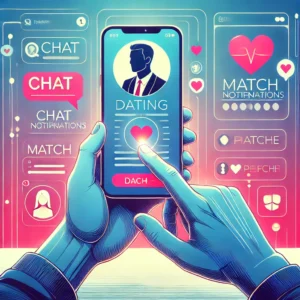
Setting the Scene: Seduction in the Digital Landscape
In the grand theatre of human interaction, seduction has always played a leading role. It’s an intricate dance, a game of chess, an art form that has been studied, mastered, and redefined across different cultures and periods in history. Today, we find ourselves in a unique era where the rules of the game have drastically shifted. Welcome to the age of digital seduction.
The digital age, characterized by the widespread use of internet technologies and social media platforms, has reconfigured the way we communicate, connect, and cultivate relationships. This shift has had profound implications for the dynamics of attraction and seduction.
In this modern landscape, seduction no longer solely belongs to candlelit dinners, stolen glances across a crowded room, or the subtle brushing of hands. It has expanded into the virtual realm, where flirtatious emojis replace suggestive smiles, and eloquently crafted texts take the place of whispered sweet nothings. The element of physicality, while still essential, often takes a backseat to the allure of online personas and the thrill of digital interaction.
The term ‘nude’ has gained new connotations in this context. In the age of sexting and online dating, a nude photo is more than just an explicit image; it’s a digital manifestation of vulnerability, intimacy, and, in some cases, a form of modern seduction. It’s a complex issue, wrapped in layers of consent, trust, and the ongoing discourse on the ethics of privacy and respect in the digital realm.
As we delve deeper into this topic, we will not only explore the nuances of digital seduction but also aim to understand its broader implications for interpersonal relationships in the 21st century. This exploration is essential for anyone navigating the often murky waters of online dating, providing insights to help guide us safely and respectfully in our pursuit of connection and intimacy.
From Courtship to Keyboards: The Evolution of Seduction
Traditionally, seduction was a process rooted in physical presence, body language, and verbal communication. It relied on an orchestra of sensory experiences: the tone of voice, a suggestive glance, the smell of perfume, the touch of a hand. Seduction was slow, an art to be mastered over time, involving a dance of subtle cues and responses, strategic advances and retreats. The arrival of the digital age has seen a profound shift in these dynamics.
With the advent of digital communication, the stage of seduction expanded from physical spaces to include the virtual realm. Our contemporary understanding of seduction has to account for this new reality where attraction can spark from a well-constructed online profile, a cleverly worded message, or even a timely sent emoji. The senses traditionally engaged in seduction – sight, sound, touch, taste, and smell – have been condensed into sight and sound, with the keyboard and screen becoming the primary tools of the modern seductor.
One of the most potent symbols of this transformation is the concept of ‘nude’ in the digital age. The nude, in traditional seduction, was a culmination of a long process of courtship, a highly intimate revelation saved for the right moment. With the rise of digital platforms and the normalization of sharing intimate images, a ‘nude’ can now be part of the seduction process. This shift is not without its complexities, as it brings up questions of consent, privacy, trust, and the potential for misuse.
The Digital Stage: Impact of Online Platforms on Seduction
Digital platforms, such as social media and dating apps, have dramatically altered the rules of the seduction game. They have expanded the dating pool, accelerated the pace of interactions, and introduced new modes of communication that have reshaped the landscape of attraction and courtship.
Online flirting, for instance, presents a stark contrast to its in-person counterpart. On the one hand, it allows for a degree of control and calculated presentation not possible in face-to-face interactions. You have the luxury of time to craft the perfect response, the ability to curate an appealing online persona, and the freedom to express interest without the immediate risk of rejection.
On the other hand, online flirting lacks the spontaneous and organic nature of in-person interaction. It relies heavily on written communication, which can often lead to misunderstandings due to the absence of tone, facial expressions, and body language. Moreover, the ease and speed of digital communication can also lead to rushed intimacy, where important stages of the relationship are skipped or compressed.
In this new arena, the traditional and digital forms of seduction co-exist and intertwine. Understanding the nuances of each can help us navigate the complexities of modern relationships, whether they bloom online or offline.
Navigating the Digital Labyrinth: The Pros and Cons of Online Seduction
As with any significant societal shift, the movement of seduction to the digital realm has brought with it a host of advantages and challenges. It’s essential to navigate this landscape with an understanding of both to make the most of the opportunities it presents, while also being aware of potential pitfalls.
Advantages of Digital Seduction:
1. Accessibility and Reach: Digital platforms have made it possible for individuals to connect with potential partners outside their immediate geographical location. This expansion of the dating pool allows people to encounter a diversity of personalities and experiences that wouldn’t have been possible within their immediate social circles.
2. Ease of Communication: Online platforms provide multiple channels for communication, from text and voice messages to video calls and even virtual reality experiences. These tools make it easier for people to communicate at their convenience, reducing the constraints of time and place.
3. Anonymity and Control: Digital platforms offer a degree of anonymity and control over one’s self-presentation. Users can carefully curate their profiles, highlighting their best qualities and interests. This control can make initial interactions less intimidating and more comfortable, especially for introverted or shy individuals.
Challenges of Digital Seduction:
1. Potential for Miscommunication: Online communication relies heavily on text, which lacks the non-verbal cues vital for understanding context, tone, and intention. This absence can often lead to misunderstandings or misinterpretations. A playful message could be interpreted as sarcastic, or a sincere compliment could be seen as insincere flattery.
2. Deception and Catfishing: The same anonymity that can make digital seduction appealing can also facilitate deception. Users may present themselves dishonestly, using edited or outdated photos, or lying about their age, profession, or personal circumstances. This phenomenon, known as ‘catfishing,’ can lead to disappointment or even harm when the truth is revealed.
3. Accelerated Intimacy: The ease and immediacy of digital communication can sometimes accelerate the pace of a relationship unnaturally. Exchanging messages late into the night, sharing intimate details, or even sending nude photos can create a false sense of intimacy that hasn’t had the chance to develop naturally over time.
4. Overreliance on Digital Interaction: Lastly, there’s a risk of becoming overly reliant on digital interaction at the expense of developing in-person social skills. Real-life interactions involve a host of skills – reading body language, maintaining eye contact, listening actively – that can’t be practiced or developed online.
In conclusion, while digital seduction opens up new avenues for connection and exploration, it also presents unique challenges. Navigating this landscape requires a balance: embracing the opportunities offered by digital platforms, while also being mindful of their potential downsides.
Unveiling Reality: Case Studies of Digital Seduction
To further illuminate the concepts discussed above, let’s delve into some real-life scenarios. These stories, with identities anonymised for privacy, provide a tangible understanding of the dynamics of digital seduction.
Case Study 1: The Power of Images
“Anna” was a regular user of a popular dating app. Having had a few pleasant experiences, she was comfortable using the platform to meet new people. On one occasion, she matched with “Chris,” and they hit it off. As the conversation deepened over several weeks, Chris expressed an interest in exchanging more intimate pictures. Initially hesitant, Anna eventually decided to share a tastefully taken nude image.
Chris was respectful, expressing his admiration without crossing any boundaries, and the exchange deepened their connection. The image became a part of their digital seduction dance, enhancing their relationship while always remaining within the realm of consent. This story highlights the potential for intimate image sharing to play a positive role in digital seduction, reinforcing trust and mutual respect between parties.
Case Study 2: The Double-Edged Sword
In contrast, “Bella” had a different experience. She shared a nude image with someone she’d been flirting with online, “Mike”. Unfortunately, Mike did not respect the privacy of the exchange. He threatened to leak the image when Bella decided to end their online relationship. Bella had to involve law enforcement, and the incident left her deeply shaken.
This experience underscores the potential risks of sharing intimate images in the digital realm. Despite the potential for enhancing connections, the misuse of such images can lead to harmful situations, highlighting the importance of trust and discretion in digital interactions.
Case Study 3: The Catfish Story
“David” was excited about his growing connection with “Sophia,” a woman he met on a social media platform. Sophia was beautiful, successful, and seemed to share a lot of his interests. After several weeks of intense online communication, David started to feel something was off. Sophia was evasive about meeting in person or video calling. David decided to investigate and discovered that Sophia’s pictures were actually those of a minor celebrity. He had fallen victim to catfishing.
David’s story is a stark reminder of the potential for deception in the digital realm. It underlines the importance of verifying the authenticity of online personas before engaging in deep emotional or intimate exchanges.
These case studies serve as practical examples of the dynamics of digital seduction, reminding us of the opportunities and risks involved in navigating these uncharted waters.
Expert Perspectives: Digital Seduction and Relationships
The world of digital seduction isn’t without its complexities. To further unpack this topic, we’ve gathered insights from leading relationship experts, psychologists, and sociologists.
Dr. Elaine K. Harding, a renowned relationship expert, emphasizes, “The digital realm is a powerful tool for connection, but it’s essential to recognize its pitfalls. The absence of face-to-face interaction can sometimes make it difficult to interpret cues and intentions accurately. We need to be mindful of these nuances.”
Sociologist Dr. James Park adds, “Digital platforms are reshaping how we form and maintain romantic relationships. However, they also introduce new challenges such as miscommunication and potential for deception. The key to navigating digital seduction successfully is to approach it with honesty, respect, and clear communication.”
Psychologist Dr. Olivia Green further points out the importance of consent in the realm of digital seduction. “When sharing explicit content like nude images,” she says, “consent is crucial. It’s not just about getting permission to send; it’s also about asking if the other party is comfortable receiving such content.”
Navigating the Digital Love Maze: Tips for Successful Digital Seduction
Armed with the insights from our experts, let’s delve into some practical tips for successful digital seduction. Remember, every individual and situation is unique, so consider these guidelines rather than rigid rules.
- Communicate Clearly: In the digital world, clear and precise communication is vital. Make sure to express your intentions and feelings transparently to avoid any misunderstandings.
- Respect Boundaries: Always respect the other person’s boundaries. If they’re uncomfortable with a topic or a line of conversation, steer clear. This respect is particularly important when it comes to sharing explicit content like nude images.
- Consent is Key: Never send explicit content without clear, enthusiastic consent from the receiver. And remember, consent can be withdrawn at any time.
- Be Genuine: Authenticity goes a long way in any form of seduction, digital or otherwise. Be yourself and allow the other person to do the same.
- Privacy Matters: If you’re sharing intimate details or images, ensure you’re using a secure platform and that the receiver understands the importance of maintaining your privacy.
- Stay Safe: Always prioritize your safety. Be cautious about sharing personal details and avoid rushing into in-person meetings. If you do decide to meet, ensure it’s in a public and safe place.
Digital seduction can be a thrilling journey, opening up new ways to connect and express intimacy. But like any journey, it’s essential to travel with care, respect, and a clear understanding of the landscape. By implementing these tips and being mindful of the experiences and insights shared in this article, you can navigate the digital realm of romance with confidence and respect.
Final Thoughts: The Future of Seduction in the Digital Age
As we’ve journeyed through the landscape of digital seduction, we’ve seen how traditional methods of romance and connection have evolved into new forms. The digital realm offers unique opportunities for intimacy and expression, yet it also brings its own set of challenges, from miscommunication to privacy concerns.
We’ve highlighted the importance of clear communication, respecting boundaries, and the crucial role of consent, particularly when sharing explicit content like nude images. We’ve also emphasized the value of authenticity and safety in our digital interactions.
Throughout our exploration, expert insights have shed light on the psychological and sociological impacts of this digital transformation of seduction. These perspectives underline the complex interplay between technology and human relationships, a dance that is ever-evolving.
As we move forward into an increasingly digital future, it’s worth considering: how will the art of seduction continue to change and adapt in the years to come? Will we find new ways to express interest, attraction, and love in the virtual realm?
As the digital age continues to unfold, remember this: the essence of seduction, whether online or offline, lies in authenticity, respect, and mutual consent. No matter how our methods evolve, these principles remain timeless and crucial to forming meaningful and respectful connections. So, in this digital era, how will you choose to navigate your journey of seduction?







